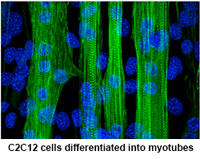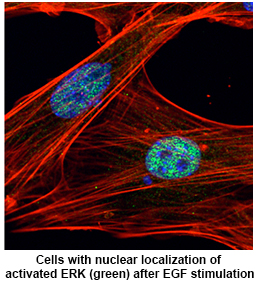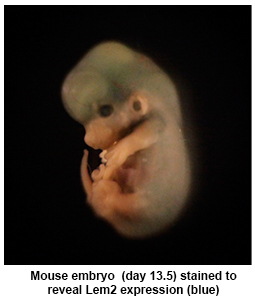The Gerace Laboratory
Research
Our laboratory has a long-standing interest in the cell biology of the nucleus and the endoplasmic reticulum (ER). Much of our current work is focused on study of the nuclear envelope (NE) and associated nuclear lamina (NL). The NE, which forms the membrane boundary of the nucleus, is a specialized subdomain of the ER. Although the NE functionally overlaps with the latter, it has distinctive properties mediated by nuclear pore complexes (NPCs) and the NL. NPCs are massive supramolecular assemblies that form channels across the NE for trafficking of protein and RNA between the nucleus and cytoplasm. The NL is a protein meshwork lining the nucleoplasmic surface of the NE that regulates the shape, integrity and mechanical properties of the nucleus. The NL also provides an anchoring site in the nucleus for the cytoplasmic cytoskeleton and chromosomes. The importance of the NL in human biology is underscored by the finding that over 15 genetic diseases (“laminopathies”) arise from mutations in lamina components. These diseases include muscular dystrophies, cardiomyopathies, premature aging, and disorders of bone, adipose and neural tissues.
The NL contains a polymer of nuclear lamins, class V intermediate filament proteins, together with associated transmembrane and peripheral proteins of the inner nuclear membrane. Proteins of the NL promote silencing of associated heterochromatin and participate in the regulation of signaling pathways controlling transcription, including MAP kinases, TFG-beta/Smad, Wnt/beta catenin, and mTOR. The lamin polymer and associated transmembrane proteins form an integrated functional unit, as similar human diseases can be caused by mutations in either lamins or NL-associated transmembrane proteins.
Nuclear lamina in regulation of signaling and chromatin.
One of our main research objectives is to understand the molecular mechanisms by which lamina-associated transmembrane proteins regulate signaling and chromatin functions. Whereas ~15 widely expressed proteins of the NL have been characterized, proteomics analysis from our lab has revealed additional transmembrane proteins enriched at the inner nuclear membrane. We are functionally analyzing several of these proteins in cultured cell and mouse models. The work is focused on cells of striated muscle and other mesenchymal tissues, which are particularly sensitive to disease-causing mutations in NL proteins. We have determined that certain TM proteins of the NL, including Lem2, Net37 and Net39, are required for proper cultured myoblast differentiation. We found that Lem2 plays a major role in attenuating MAP kinase signaling in the nucleus, and that disruption of the gene for Lem2 in mouse leads to mid-gestational embryonic lethality. Using a conditional knockout allele, we now are analyzing the functions of Lem2 in skeletal muscle and other tissues of adult mouse. A muscle-specific knockout leads to an apparent degenerative phenotype, whereas a liver knockout causes metabolic disruption. In tandem, we are using cultured myoblast and fibroblast models to identify the signaling effectors that interact with Lem2 to mediate MAP kinase regulation. In another project, we have determined that Net37, which contains a glucosidase domain localized to the NE lumen, has an apparent role in the folding and secretion of a select group of proteins including follistatin, an essential myogenic regulator.
Mapping the organization of the nuclear periphery.
Our laboratory is a component of the NIH 4D nucleosome consortium <https://commonfund.nih.gov/4dnucleome>, which aims to understand the structural organization of the nucleus in the context of gene expression, development and disease. In collaboration with the Yates laboratory at TSRI, we are seeking to map the functional organization of NL proteins by determining how they interact with each other and with chromatin components to support signaling and heterochromatin regulation. For these studies, we use a mesenchymal stem cell (MSC) model to analyze changes in NL organization during differentiation into myocytes and adipocytes. Our approach includes charting the dynamic features of NL organization by proximity labeling and crosslinking-mass spectrometry approaches. Our studies also have uncovered several novel NE proteins with potential relevance to signaling regulation, nuclear membrane dynamics and cytoskeletal attachment to the nucleus. The work is generating quantitative insight on lamina organization and its changes during differentiation, providing a framework for using modeling approaches to study NL functions.
Trafficking of HIV-1 unspliced mRNA in cells.
In a project stemming from our interest in nucleocytoplasmic trafficking, we have been investigating the nuclear export and trafficking of HIV-1 unspliced mRNA, which occurs in ribonucleoprotein (RNP) complexes. One pool of unspliced HIV mRNPs is incorporated into newly forming virus particles as the viral genome, and a second pool is translated to produce the major viral structural proteins. We have used affinity approaches to isolate cytoplasmic unspliced HIV mRNPs, and from SILAC proteomic analysis, have identified proteins with potential roles in specifying the alternative fates of encapsidation vs translation. We now are working to unravel the roles of these proteins in the HIV life cycle. These proteins could provide a new window of insight into HIV biology, and may afford therapeutic targets for interdicting virus replication.




